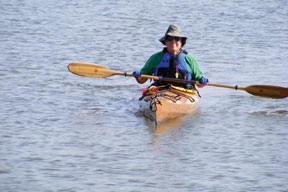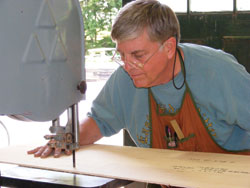 Jack Spurway ’69 designed the addition to his house on Crawfordsville’s Wabash Avenue so that he’d be able to take out the 18-foot kayak he was building in the second-floor loft.
Jack Spurway ’69 designed the addition to his house on Crawfordsville’s Wabash Avenue so that he’d be able to take out the 18-foot kayak he was building in the second-floor loft.
"He just slid it down into the kitchen and out onto the top of the car in the new garage," says his wife, Guyanna. "That’s the engineer in him. He knows every inch of this place."
But there’s not enough room in the house for his next project. He’s going to build a sailboat, a 16-foot sloop modified from the plans of a 19th-century naval designer. Spurway spent four weeks last summer at the WoodenBoat School in Brooklin, Maine, learning how to do it.
"It was like a summer camp for old farts," says Spurway, who threw his kayak on top of his car in July
and drove to the 60-acre "saltwater campus" that hosts more than 600 students, faculty, and guests each year in classes ranging from boat building and seamanship to marine photography and watercolor.
"I had decided it’s too much work to paddle a kayak," the former English major turned industrial designer says. He had taken to the water a decade ago, enrolling in whitewater kayaking classes at IU Bloomington, then taking sea kayak expeditions in the Tortugas and Alaska before building his own kayak.
"I thought, Why buy one when I could build one?"
He’s been following that logic since he was eight years old, when he asked his father to buy him a sled. His father wouldn’t, so Jack built his own. He built go-karts, began working in construction when he was 16, and had his own crew by the time he was 17. When he was 14, his father was out of town and his mother wanted a swimming pool. Jack had the hole dug, and figured out the rest himself.
"I’ve always been building something," he says. "Then you become a homeowner, and you spend your time rebuilding. My new challenge is to build a sailboat."
After a vacation in New England last year, the flatlander made a decision: "If I can’t move to Maine or the East Coast, I can build a sailboat and bring it back here—sail it on Indiana reservoirs and Lake Michigan."
Eleven months later, he was pulling up to the Wooden-Boat School.
"It was like being back in college," the 62-year-old says of the room he shared in the school’s dormitory. "You have a bed, a dresser, and some shelves to put your stuff on. Then you focus the day from eight to five—and some evenings from six to nine—building boats. The time went very fast, but you still found yourself looking forward to socializing at the end of the day. The effort of learning how to do the work, taking pictures so that it all makes sense, taking notes—I have 100 pages of notes!"
The first two-week class focused on woodworking fundamentals—the methods of joinery and basic skills needed to build boats. A confidence builder for Spurway.
The second class reminded him more of his Wabash days. He was one of only two in the class who hadn’t previously worked with the instructor. The class was way ahead of him, and he didn’t know the ropes.
"That’s a Wabash course right there: You walk in cold, you’re already behind the eight ball, and you have an assignment you didn’t know you had. I’m there to learn, but the instructor wants to build. It’s like getting thrown into the water to learn how to swim. I made some mistakes, but they were small enough that they didn’t make a difference."
 Spurway spent his free time paddling his kayak in the harbor, sailing, or reading. He’d read a half-dozen books on the craft before the classes, and he kept another—The Zen Compass—alongside them in the overstuffed duffel bag he calls his "portable library."
Spurway spent his free time paddling his kayak in the harbor, sailing, or reading. He’d read a half-dozen books on the craft before the classes, and he kept another—The Zen Compass—alongside them in the overstuffed duffel bag he calls his "portable library."
"Stop thinking about it and just do it," Spurway says when asked how Zen applies to boat building.
Before he left to return to Indiana, he also bought books by his two instructors. As Spurway shows them to me, he realizes he hasn’t yet read what his teachers had written when they signed them for him.
"Great to have your enthusiasm and sense of humor," that tough second instructor wrote, noting that the boat they started together is only the second John Brooks Designs Somes Sound 12 1/2 sloop ever built.
"Why sense of humor?" I ask.
"Probably because I was a smartass," Spurway says.
The second inscription reads: "To a top-notch builder. Keep building those wooden boats."
Spurway’s dad threw out his son’s sled not long after he built it, but Jack’s nautical projects are more appreciated. Coveted, in fact.
"My son-in-law and grandson already have their names in for them when I’m gone." Spurway laughs, but he’s not displeased.
"Building this boat brings back something that has been lost," he says. "The guy who designed the original boat—he built tremendous yachts; he was a genius. Building this brings that forward."
A man could pass worse things on to his kids and grandkids.
When Spurway goes back to Maine next summer, he’ll join his classmates finishing the boat they started last July. Then the boat will be auctioned off to one of the students for the cost of the materials.
Spurway’s not interested.
"I don’t want to put my name in for the one all of us are building. I want my boat to be the one I build—I want it to be mine."
So after class next year, he plans to bring back a 700-pound lead keel for the boat he’ll be crafting in his friend Gordon Huffaker’s cabinet shop.
"If I have the keel, I’ll have no choice but to finish it," he says. "Where in Indiana can you get rid of 700 pounds of lead?
"Some days I wake up and it scares the hell out of me. I’m buying 20 planks of 18-foot-long beautiful, clear mahogany and cutting it up. And $150 sheets of plywood. Spending all this money.
"On the other hand, I’ve got the rest of my life to work on this."
As we finish our conversation on the deck he built in the back yard he planned and planted, he notices a gold-finch wrestling for seeds in a large yellow flower.
"Stupid bird," he says, pointing to the birdfeeder full of seeds only a few yards away. "He could get all he needs right over there."
"Reminds me of someone else I know," I say. Jack grins. He, of all people, should understand that things taste a little better when you have to work for them.